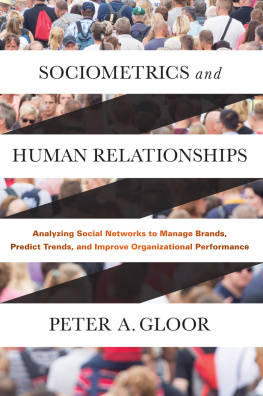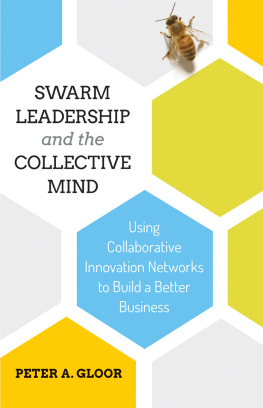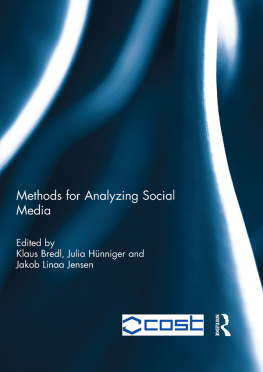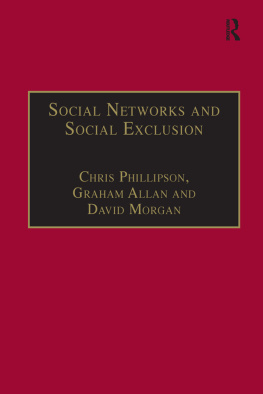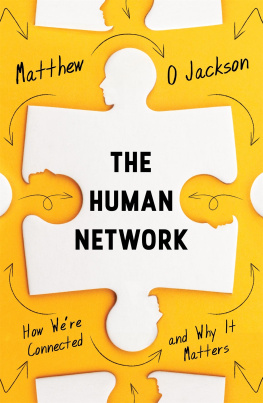Gloor - Sociometrics and human relationships - analyzing social networks to manage
Here you can read online Gloor - Sociometrics and human relationships - analyzing social networks to manage full text of the book (entire story) in english for free. Download pdf and epub, get meaning, cover and reviews about this ebook. year: 2017, publisher: Emerald Publishing Limited, genre: Home and family. Description of the work, (preface) as well as reviews are available. Best literature library LitArk.com created for fans of good reading and offers a wide selection of genres:
Romance novel
Science fiction
Adventure
Detective
Science
History
Home and family
Prose
Art
Politics
Computer
Non-fiction
Religion
Business
Children
Humor
Choose a favorite category and find really read worthwhile books. Enjoy immersion in the world of imagination, feel the emotions of the characters or learn something new for yourself, make an fascinating discovery.
- Book:Sociometrics and human relationships - analyzing social networks to manage
- Author:
- Publisher:Emerald Publishing Limited
- Genre:
- Year:2017
- Rating:4 / 5
- Favourites:Add to favourites
- Your mark:
- 80
- 1
- 2
- 3
- 4
- 5
Sociometrics and human relationships - analyzing social networks to manage: summary, description and annotation
We offer to read an annotation, description, summary or preface (depends on what the author of the book "Sociometrics and human relationships - analyzing social networks to manage" wrote himself). If you haven't found the necessary information about the book — write in the comments, we will try to find it.
Gloor: author's other books
Who wrote Sociometrics and human relationships - analyzing social networks to manage? Find out the surname, the name of the author of the book and a list of all author's works by series.
Sociometrics and human relationships - analyzing social networks to manage — read online for free the complete book (whole text) full work
Below is the text of the book, divided by pages. System saving the place of the last page read, allows you to conveniently read the book "Sociometrics and human relationships - analyzing social networks to manage" online for free, without having to search again every time where you left off. Put a bookmark, and you can go to the page where you finished reading at any time.
Font size:
Interval:
Bookmark:
SOCIOMETRICS AND HUMAN RELATIONSHIPS
Analyzing Social Networks to Manage Brands, Predict Trends, and Improve Organizational Performance
SOCIOMETRICS AND HUMAN RELATIONSHIPS
Analyzing Social Networks to Manage Brands, Predict Trends, and Improve Organizational Performance
BY
PETER A. GLOOR
MIT Center for Collective Intelligence, Massachusetts Institute of Technology, Cambridge, MA, USA

United Kingdom North America Japan
India Malaysia China
Emerald Publishing Limited
Howard House, Wagon Lane, Bingley BD16 1WA, UK
First edition 2017
Copyright 2017 Peter A. Gloor
Reprints and permissions service
Contact:
British Library Cataloguing in Publication Data
A catalogue record for this book is available from the British Library
ISBN: 978-1-78714-113-1 (Print)
ISBN: 978-1-78714-112-4 (Online)
ISBN: 978-1-78714-725-6 (Epub)
 |  |
The tools and methods described in this book have been developed and tested over the last 12 years in the Collaborative Innovation Networks (COINs) seminar. I am deeply grateful to all my instructor colleagues, and of course to the hundreds of students from the United States, Finland, Germany, Switzerland, Chile, Italy, South Korea, and China who have contributed many creative ideas, and have taught me what works, and what does not.
The COINs seminar was started at MIT Sloan in spring 2005. In fall of the same year, the seminar morphed into a virtual distributed course joined by students from Helsinki, supervised by Maria Paasivaara and Casper Lassenius, students from Cologne tutored by Detlef Schoder and Kai Fischbach, and students from Savannah College of Art and Design (SCAD) lectured by Christine Z. Miller. In the meantime, the seminar has also repeatedly been taught at Pontificia Universidad Catolica Santiago de Chile coached by Cristobal Garcia Herrera, and University of Applied Sciences Northwestern Switzerland, where Michael Henninger has been the indispensable instructor. Since 2011, the students from Cologne have been coached first by Johannes Putzke, and since 2014 by Gloria Volkmann, while at University of Bamberg, students have been instructed by Kai Fischbach and Matthaeus Zylka.
The software tool Condor that is the basis of this course was started in 2003, when the Center for Digital Strategies at Dartmouth College under the leadership of Hans Brechbhl and Eric Johnson agreed to support Yan Zhaos software development efforts as part of her Masters thesis supervised by Fillia Makedon. For the next three years, Yan, ably supported by the algorithm genius of her husband Song Ye, built the first two versions of Condor, originally called TecFlow. End of 2006, she passed the baton to Renauld Richardet, who added Apache Lucenes text processing capabilities. In 2008, Condor development continued in Switzerland at galaxyadvisors, funded by the Swiss Commission for Technology and Innovation CTI. Michael Henninger, Hauke Fuehres, Martin Stangl, Lucas Broennimann, Marton Makai, and Kevin Zogg from the University of Applied Sciences Northwestern Switzerland (FHNW) worked on building a fundamentally revised version of Condor in the team of Manfred Vogel and Andr Csillaghy at the Institute for 4D technologies i4ds. Since 2013, Condor development is done by my colleagues at galaxyadvisors, Marton Makai, Hauke Fuehres, and Joao Marcos Da Oliveira, supported from 2014 to 2015 by Karsten Packmohr.
This book is the product of many people working together over 14 years, building the tools and methods described here. First of all, I am grateful to Ken Riopelle and Michael Henninger, who have been essential in making the social media analysis tool Condor accessible to a wider audience beyond programmers and statisticians. Ken created the first Condor videos, and wrote a comprehensive manual, the precursor of this book. Michael wrote the first tutorial for Condor in the COINs seminar at University of Applied Sciences Northwestern Switzerland. Ken Riopelle, Michael Henninger, and Lucas Broennimann provided valuable feedback on earlier versions of this manuscript. Ken also contributed the last section of Chapter 3 of Part II.
My sincerest thanks to all of you, without your creative ideas, didactical talent, and Java development and software architecting skills, both the COINs course and Condor would not exist.
Imagine being able to spot if a customer is becoming really unhappy with your product and service and do something about it before they actually leave you.
Imagine finding out what the constituency of a politician or political party really thinks.
Imagine finding out what your customers love and hate about your product.
Imagine being able to identify your most creative employees, your external innovators, and lead users and help them become even more creative.
Imagine being able to predict who wants to leave your company, your department, or your project team and not just identify them, but help them become happy and motivated workers again.
Imagine identifying potentially fraudulent or risky behavior among your employees before they actually commit anything illegal.

If you are looking for answers to these and similar questions, read on. This book gives you a framework to analyze your organization from the inside, by mining e-mail, skype, and calendar data, and from the outside, by crunching Twitter, Wikipedia, and blog data.
From your and your organizations e-mail, skype, and calendar data, you can:
- Find out about the happiness of your employees (see Section 9.3).
- Find out about the satisfaction of your customers (see Section 9.3).
- Find out who might be leaving your company (see Section 9.3).
- Find your most creative and motivated employees (see Chapter 10).
- Find out about the willingness of your employees to take unnecessary risks (see Section 11.3).
From Twitter, Wikipedia, and blog interaction data, you can:
- Find out about what your customers and prospects really think about your company and your brands (see Chapter 12).
- Measure the strength of your brand (see Chapter 12).
- Find out about the demographic profile of the customers and aficionados of your company and brands (see Section 14.3).
- Forecast the popularity and voter share of a politician (see Section 14.2).
- Find out about the demographic profile of the voters of a politician (see Section 14.3).
These are just a few use cases that we will address to study how humans communicate and collaborate inside the organization, through e-mail, chat, videoconferencing, and face-to-face communication, and outside on online social media. Better communication leads to better collaboration, which leads to more and better innovation! This book describes algorithms and tools to find and support collaboration within and between organizations. Our approach puts a lens to the organization by mining electronic communications such as e-mail, sociometric badges, telephone, chat, online meeting, Web/videoconferencing, and calendars to make existing communication patterns visible. The Condor software tool, which has been developed over the past decade at the MIT Center for Collective Intelligence and the University of Applied Sciences Northwestern Switzerland, mines these electronic archives and generates a broad range of structural, temporal, and content-based social network metrics which can be used to calculate and forecast all of these real-world insights mentioned above (.
Font size:
Interval:
Bookmark:
Similar books «Sociometrics and human relationships - analyzing social networks to manage»
Look at similar books to Sociometrics and human relationships - analyzing social networks to manage. We have selected literature similar in name and meaning in the hope of providing readers with more options to find new, interesting, not yet read works.
Discussion, reviews of the book Sociometrics and human relationships - analyzing social networks to manage and just readers' own opinions. Leave your comments, write what you think about the work, its meaning or the main characters. Specify what exactly you liked and what you didn't like, and why you think so.

